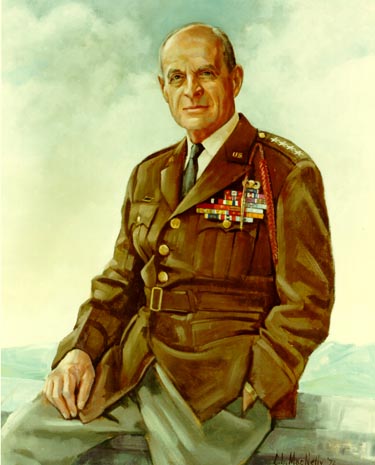By Clarence Lamont MacNelly
Oil on canvas, 38
Matthew Bunker Ridgway was born at Fort Monroe, Virginia, on 3 March 1895; graduated from the United States Military Academy, 1917; was commissioned a second lieutenant in April, a first lieutenant in May, and a temporary captain in August 1917; was a company commander and adjutant of the 3d Infantry, 1917–1918; was instructor in Spanish and athletics executive at West Point, 1918–1924; was promoted to permanent captain, 1919; graduated from the Infantry School at Fort Benning and served with the 15th Infantry in China and the 9th Infantry in Texas, 1925–1927; served on the American Electoral Commission in Nicaragua and the Bolivia-Paraguay Commission of Inquiry and Conciliation, 1927–1929; married Margaret Wilcox, 1930 (divorced 1946); served with the 33d Infantry in the Canal Zone, 1931–1932; was technical adviser to the governor general of the Philippines, 1932–1933; was promoted to major, October 1932; graduated from the Command and General Staff School at Fort Leavenworth, 1935, and the Army War College, 1937; was assistant chief of staff, G–3, of Sixth Corps Area, Second Army, and Fourth Army between 1935 and 1939; served in the War Plans Division of the General Staff, 1939–1942; was promoted to lieutenant colonel, July 1940, and to temporary ranks of colonel, December 1941, brigadier general, January 1942, and major general, August 1942; commanded the 82d Airborne Division in operations against Axis forces in Sicily, Italy, and France, 1942–1944, and the XVIII Airborne Corps in European operations leading to Germany’s surrender, 1944–1945; was promoted to temporary lieutenant general, June 1945; commanded the Mediterranean Theater of Operations and was Deputy Supreme Allied Commander there, 1945–1946; married Mary Anthony, 1947; was representative of the United States to the United Nations Military Staff Committee and chairman of the Inter-American Defense Board, 1946–1948; was commander in chief, Caribbean Command, 1948–1949; was deputy chief of staff for administration, 1949–1950; commanded the Eighth Army against Communist forces in Korea, 1950–1951; was promoted to general, May 1951; was American and Supreme Allied Commander in the Far East, 1951–1952; was Supreme Allied Commander in Europe, 1952–1953; was chief of staff of the United States Army, 16 August 1953–30 June 1955; dealt with postwar demobilization, training of the South Korean Army, strengthening of the North Atlantic Treaty Organization, establishment of a NATO line of communications, potential crises in Indochina and Formosa, and the effects of budget cuts upon the Army’s capability to carry out its mission; retired from active service, June 1955.
The Artist
Clarence Lamont MacNelly (1920–1986), graduate economist, Navy officer, pilot, advertising executive, magazine publisher, jazz pianist, and portraitist, has created the likenesses of a wide variety of subjects beyond those of Generals Omar N. Bradley and Matthew B. Ridgway. His images of children are especially appealing, and his Navy background led him spontaneously to the field of yachting and portraits of several prominent skippers like Robert Lyon Hamill. His portrait of one of America’s great performers, Jimmy Durante, has garnered considerable critical acclaim. Art runs in the family; MacNelly’s son Jeffrey won a Pulitzer Prize as cartoonist of the Richmond (Virginia) News Leader.
Matthew Bunker Ridgway
By Clarence Lamont MacNelly
Oil on canvas, 38![]() "
x 28
"
x 28![]() ",
1972
",
1972
[128]

[129]